Here to enjoy geology and videogames, and maybe explain them just a little! Ph.D. metamorphic petrologist/geochemist
Last active 4 hours ago
Don't wanna be here? Send us removal request.
Text
Geology and the Extinct Silver Trout
Okay... this is a little out of the scope for this blog I admit... But two days ago I watched this YouTube Documentary by Atlas Pro linked here.
It was super interested and I recommend giving it a watch...and I really can't stop thinking about it.
The REALLY short blip of this entire documentary is looking for the extinct silver trout (Salvelinus agassizii) that was found in these two lakes in Connecticut that were then overfished, and then later outcompeted by introduced species.
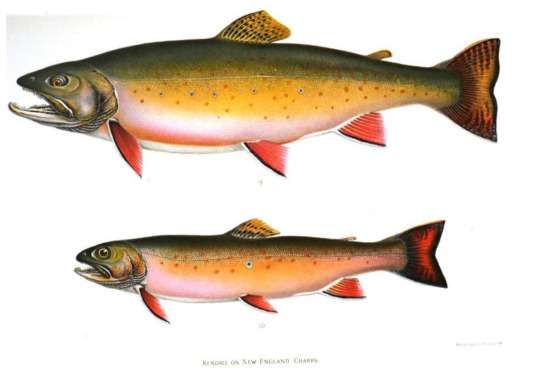
A sad story, as most extinction stories are, but there was a lot of interesting points that were brought up in this video, and in very old records regarding the fish and I would like comment briefly on all of this!
First, some background info:
These fish were found in 2 lakes hundreds of miles away from one another, yet not found in any other lakes, ponds, rivers between the two today (notice the stress on today).
Except... 20~ish thousand of years ago these lakes were along rivers that connected to a large glacial lake named Glacial Lake Hitchcock.
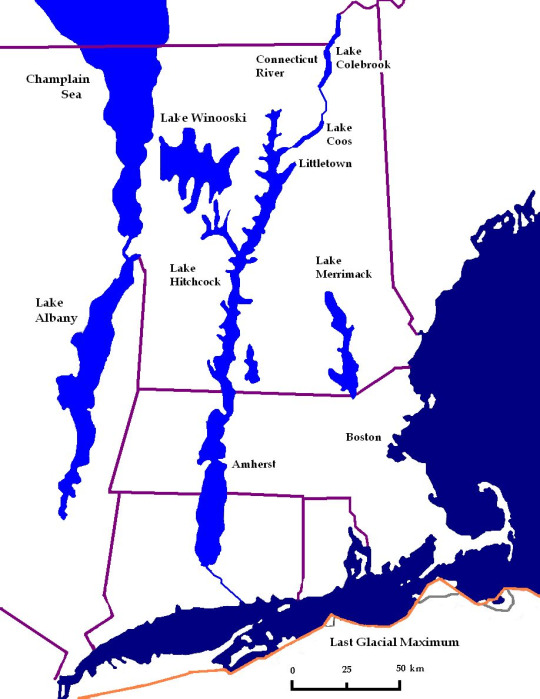
Tragically, Lake Hitchcock catastrophically emptied a couple thousand years after forming, leaving the original population of these silver trout gone, and these small remnant populations, very far apart from one another.
I won't really get into the overfishing practices or anything like that because I want you to watch Atlas Pro's video. But something that stuck out to me was that it was a man named Aggasiz's request that specimens of the fish be sent to be identified in the first place, but otherwise I am unsure of if they would have been identified sooner due to the ambiguity of the fish being used against it to allow for more fishing (avoiding fishing seasons and such).
But this entire video I heard whispers of that name, that I couldn't shake off. The name Louis Aggasiz... Now for the geology community this may ring some bells as the first man to hypothesis about the existence of ice ages!
And upon looking it up, it was in fact the same Louis Aggasiz!
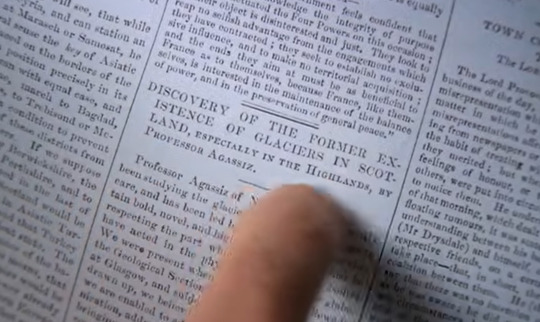
How ironic right? Agassiz the man who first considered ice ages (documentary about that here), had also been the person to push for the identification and preservation of a fish population created because of a glacial lake that occupied the area thousands of years ago.
Anyway!!
One of the questions Atlas Pro had at the was quite simple. "two of these lakes hosted these populations, could there be more remaining we had never discovered? A fun idea to ponder! Especially because these locations still have large swaths of pristine land.
He opened this out to researches and people about to go into a Master's and Ph.D. to look into! and I also agree. This could be the perfect collaborative study in geology, geography, and biology!
Anyway, I hope y'all watch the video and the documentary linked. I have since binged a lot of Atlas Pro's content and it filled the void that was forming from lack of Miniminuteman's videos. Later!
#geology#rocks#stem#science#media#biology#geography#ecology#conservation#fish#trout#academia#outdoors#nature#northeast#extinct species#extinct animals#paleontology#glaciers#history
54 notes
·
View notes
Text
A Guide to Geological Discoveries in your Fictional World
Let's learn how to write a realistic way of discovering geology in your world, (whether it be for mining, discovering your world 'origin' story, some religious undertones, or for whatever your worldbuilding purposes) by looking back into the past at how modern geology was initially discovered.
**I am mostly going to format this as a story with interjections of how this relates to plot and character. I think this concept is very important, if only that it talks about concepts that we might find as 'common knowledge' today, and realize they were major discoveries in a more historic setting.
Today we will talk about a name that is held in high esteem in many a geology household, James Hutton. The father of modern geology.
*Disclaimer: I am going to be disrespectful to him, but I promise it is with a heart full of love that I do so.*

Lets set the stage, James was alive from 1726-1797 in Scotland. At this time, the church was everything. So geology was a little... might I say, sacrilege? *gasp*
Anyway, what made this man begin to think about the rocks around him? Easy, he knocked up a girl and got banished to his family's farm and while farming he watched his soil wash away every year, and James thought "What the hell is up with that God?"

So being a religious man he thought to himself... Well God definitely wouldn't forsake us, so the Earth which he created must function around a system! Where some areas are washed away, and eventually get deposited creating new land!

Wow! for a (granted educated man) but still a guy on a farm to come up with geology just so that he could reconcile his religion? Crazy impressive.
*Now do your characters need to start thinking of geology in that way? No. BUT! I think it is important to put your character into a situation where they are experiencing geology. I think geology concepts are hard to imagine locked away behind books and in a lab. That is something to really keep in mind while developing a character who might imagine something about geology.*
* I also think it is important that IF you have a religion or gods in your world, you can reconcile geology the same way this man did.*
Now, this realization might not seem very crazy to us, but it is. Why? Because of the amount of time it would take to create landmasses. Hutton understood that this would mean the Earth is older than what was taught at the time (~6,000 years), DARWIN WASN'T BORN YET. Buddy was really out there fighting on his own, but your characters don't have to, pairing geology and evolution is a smart choice because both concepts build on each other.
How can this be relevant to your fantastical plot though? Proof to take down an evil church (you would need more facts than just this but that is the job of some other characters). A creation myth of your continent. Someone literally as old as dirt. Deep time topics like magical creature evolution or something like that.
This was just Hutton's first idea he came up with but he knew ALL rocks weren't sedimentary rocks (rocks made on the surface from dirt and other rocks), so he knew there must be more ways rocks formed.
His second idea he came up with while hearing about an incident at a glass bottle factory (the furnace stayed on and the glass cooled slowly and they formed crystals).
Volcanism was known to happen. The fast cooling igneous rocks could be observed forming (though I'm not sure if they actually knew at this time or not and I refuse to google it) and thus COULD be known to come from molten rocks, but coarse-grained igneous rocks (granite) were thought at the time to be created by God himself (obviously, this is going to be a problem in the future).
Hutton hearing about to bottles had a brain blast, and was like "OMG granite used to be molten!"
If geology is relatively established in your world, this is the idea a lab rat could DEFINITELY have. But a really important question you might be having at this point is "What can I use this information for? How is this relevant to my plot?"... well I am sure you can come up with better reasons then little ole bird here, but I might use this for decoding a mystery of magic crystal formation, again some origin myth, or event as a way to hint towards an upcoming natural disaster.
Anyway, Hutton's friends around this time were like "You should totally present this to people! Everyone will totally believe you!"
(Everyone did not believe him and they told him he was a pagan and that REALLY upset Hutton)
I think this is really important to mention. People DIDN'T believe Hutton. Your character will have an uphill battle and will have to prove themselves time and time again.
What did Hutton do though? He got on his horse (literally) and he found granite that had been injected into another rock before hardening. As in, he found granite behaving as a liquid (He shut up the haters).
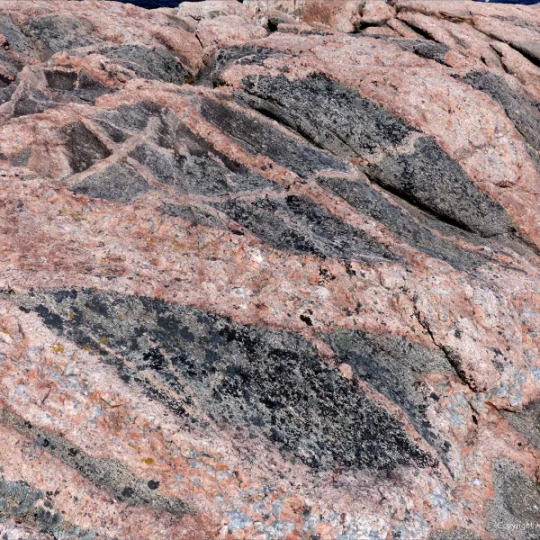
After Hutton (and after Kelvin, fuck that guy, he set geology back so many years as a science he can rot in hell), geology was cool, people began studying it more, trying to understand the ages and relationships of rocks, we were all having a good time until we hit this really hard to swallow concept... Ice Ages....
And then a side of continental drift and plate tectonics which apparently! made a guy have literal mental breakdown when he thought of giant sheets of rock moving. Which I mean like... fair enough. But I won't go into this topics as much because they carry the same concept as what Hutton experienced which is:
Science is very 'need to see it to believe it' and back before we had a great grasp on geophysical and geochemical tools geologists utilize today, there wasn't a lot of ways to observe geology other than "boy doesn't it kind of look like this other thing I have observed? Maybe that's because they are kinda related."
**Anyway, I tried to keep this one short because there was only a couple points I wanted to drive home and the rest I was just bein' funny. This post really is building off two other guides I wrote about 'mining', and 'economy and trade'. So if there is anything you need expanded on I do recommend those guides. And as always, if you have any specific questions I can happily answer them!
**Most of this info came from a docu-series called "Men of Rock", it's a good series and I highly recommend it for non-geo and geo people alike. I re-watch it at least once a year just to feel something. (it's on youtube)
#geology#rocks#stem#science#creative writing#fictional world#worldbuilding#dnd worldbuilding#writing research#writing resources
18 notes
·
View notes
Note
What's your favorite kind of rock, and what's the worst depiction of it (or lack of depiction in an environment that should have it) that you've seen in media?
I have taken... several days to think about this. Unfortunately, I feel this question would be better asked to someone who might study igneous or sedimentary rocks. So if anyone else in either of these fields or otherwise has some topics to touch on, please give your Ted Talk. Until then, I will do my best to answer!
First things first, I study metamorphic rocks, which are rocks that used to be other rocks, but then were exposed to heat and pressure until they became something fundamentally different.
That's vague though! Specifically, I study rocks that formed in an ancient subduction zone and have come back up to the surface to tell the tale. My favorite kind of rock to look at is a blueschist, but I think the coolest rock around is eclogite (and also rodingites, but they are unrelated to the rest of this).
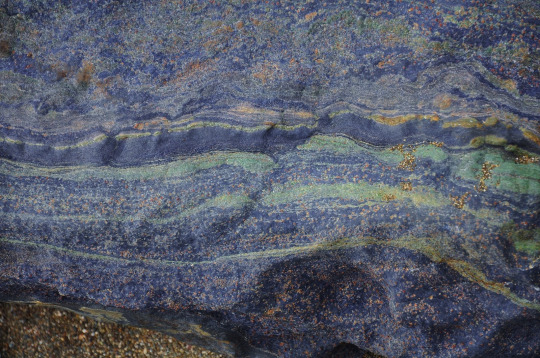
A blueschist
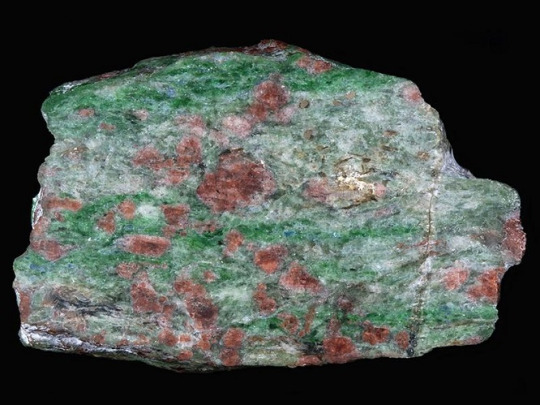
an eclogite
Both of these are formed in subduction zones, just at different depths.
Now how does this become problematic... well... these are all formed very deep in the ground, so I can't really be made at media for not depicting them, let alone depicting them incorrectly.
That said...I have so much ranting I can and will do about geology in general, because it is not mentioned enough in media in any capacity.
Trying to find good geology documentaries is a struggle in a sea of nature and space docs. Even while watching a documentary about space the other day, they had phrased something in such a way that it wasn't "wrong" but if uninformed it would cause an EXTREME misunderstanding just because of poor wording.
I had to pause the video and call my significant other in for him to witness it as well, and this is a DOCUMENTARY for goodness sake. I am not even talking about the conspiracy leaning documentaries they show on the science channel.
Which I serious hate those! Why can nature documentaries get all these shows where they are just telling a story about the beauty of nature and geology documentaries always have to 'draw people in' by suggesting there is a blackhole in the Bermuda triangle or something outlandish. You have to wade through 40 minutes of crazy ass ideas to get to 10 minutes of actual science.
My ideal geology documentary would be them going to a region and taking you out in the field, showing beautiful scenery of today, and then looking at the rocks, talking about what they mean and taking you 'back in time' to see what that might have looked like when those rocks were formed.
You could make so many of those!!! some with every rock type, where people do actual science, and you still get to look at beautiful landscapes, but you also get to LEARN.
Anyway, documentaries aren't the only problem, I love fantasy. I love it. However, what makes fantasy incredibly good is when major plots are rooted in some general idea of truth. And that is true for a couple reasons!
If your idea is founded in some kind of truth, it takes less time to have to explain and people viewing don't have to take time to 'make it make sense' another reason its helpful to have some fleshed out idea built on real life principles is because it helps the person who is making it, as in, if you aren't sure of what this should look like or 'what would happen if you did this to that' you have something similar to look up and find out.
Now not everything has to 'make sense' but at least some things should.
You should not be finding coal right next to gemstones, it isn't realistic, and it pisses me off.
Also, of course I hate movies with unrealistic natural disasters... its not even necessary to depict unrealistic things. There have been super crazy things that have ACTUALLY happened in earth's history that in modern day would have devastating effects.
Anyway, apologies I couldn't grant you the rant you may have wanted, but it did feel good to get some things off my chest!
18 notes
·
View notes
Text
Hi! This is super interesting, So I want to expand of this a bit on my ideas!
my first thought would be to make the upper crust a sedimentary rock, I think the most visually interesting one could be a conglomerate
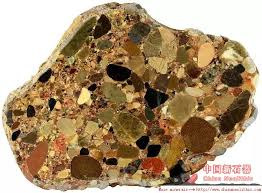
but I imagine it would be kind of interesting to have a variety of sedimentary rocks, like coquina, sandstone, limestone (with lots of fossils), etc.
The mid crust is usually an amphibolite (a metamorphic rock). These rocks characteristically have something called 'foliation' which is a fancy way of saying the minerals have a preferred orientation (it has layers).
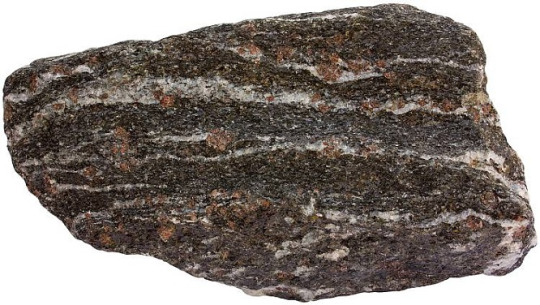
and the deepest one being a peridotite (upper mantle) or a gneiss (lowest crust). Peridotite is what the mantle is made up of, its very pretty and Gneiss/granulite you might notice looks a lot like amphibolite. That is because they are both metamorphic rocks, but with increasing grade (gneiss/granulite being a higher grade than amphibolite).
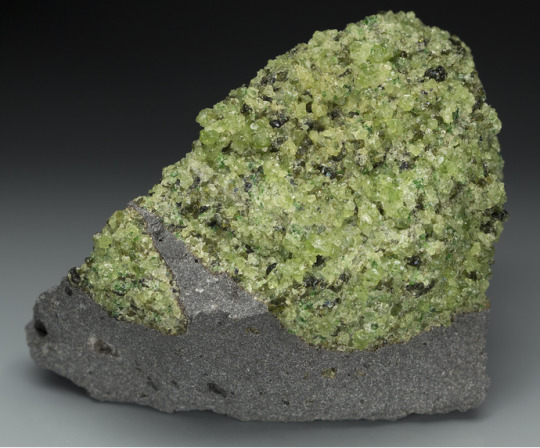
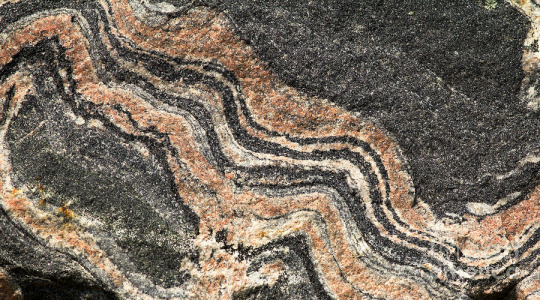
If you were to use this system, sedimentary rocks gems/resources would be primarily coal/oil, iron (think rust and pyrite), lead (galena), and I think that is mostly it. However those are just, like, practical things. You could also include clay, as it is an important resource and fossils because those are only found in sedimentary rocks. You can also have a rare drop rate for things like diamonds, sapphires/rubies and gold. Sedimentary rocks are by nature, a rock made up of other rocks. Because of that, they can have just about anything in them, but sediments tend to become density separated, so high density things like the things I listed above can be found in sediments in a high enough amount to be mined!
For Amphibolites, they are just middle range metamorphic grade rocks, so some minerals that form in those kinds of conditions would be rubies and sapphires, emeralds, garnets, mica, talc, and some resources could be also iron (pyrite), copper (malachite/chalcopyrite), gold (gold), OH! and also graphite maybe? (the ores I have listed are typically formed from hydrothermal fluids because of that they can also be applied to the volcanism section listed later). To be clear though, there is amphibolite grade metamorphism (it indicates the pressure and temperature these rocks form at) and there is a rock specifically called an amphibolite. Do your best to try not to mix them up but if you need help you can always DM me.
For Peridotites, these is where we can bring in diamonds. Peridotites are typically made up of spinel (can be gem quality) olivine (I think the gem name for it is peridot), pyroxene, and garnet. However, diamonds are formed in the upper mantle, so this is where you could insert them.
If you did gneiss/granulite it would just be the same minerals as amphibolite.
You could also go a couple other directions though! So let us not exclude other ideas (but I will talk less about them).
you could just follow a metamorphic grade path shown below.
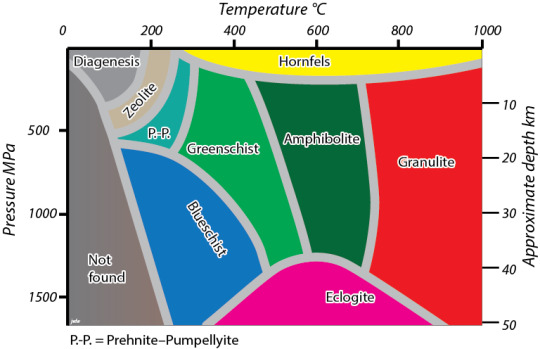
if you go this path you can just google things like "common minerals at such and such facies" and it should give you a decent list.
All of these ideas though have excluded igneous/volcanic rocks. If you wanted to include them, it might be worthwhile to add volcanic rocks like basalt, rhyolite, andesite, obsidian, tuff, pumice to surface/upper crust stuff and then add granite, diorite, and gabbro to middle crust. For lower crust, I would choose migmatites, as granulites usually start to partially melt(so we rename them migmatites to clarify) which looks really cool! But to be clear, metamorphic rocks never fully melt otherwise they would be considered igneous/get renamed. If you did this you could add in geodes/agate, petrified trees and the like, to the volcanic rocks and you could add labradorite/moonstone, garnets, quartz/smoky quartz, biotite, topaz, and aquamarine to the middle crust igneous rocks. Migmatites don't really add anything to the lowest layer, just vibes...
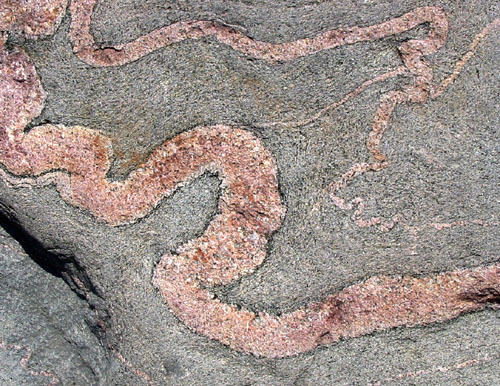
those squiggles look like granite right?! that's because it is! that is melted rock that re-solidified.
In terms of likelihood for occurrence, Other than what I listed for sedimentary rocks, and making diamonds a rarer drop rate for peridotites, I feel it is up to your own discretion.
Also, apologies I am not going to proofread this, which is honestly just my brand at this point, but if you need clarity please message me and thanks for reaching out to learn about geology! I can't express how happy it makes me when people put in an effort to have correct geology.
Hey geologists I need a bit of help with my worldbuilding.
So I'm adding dwarves to my setting but not your typical short stubby fleshy dudes. But rather short stubby rocky dudes. There are three types of dwarves upper crust, mid crust, and lower crust. They grow at different levels in the earth's crust and are made out of different rocks depending on what's available at that level. Like if they're closer to the surface they're made out of rocks and gems and such that naturally grow at that level.
Small issue though I have no idea what grows- forms? At those different levels farther or closer to the surface and I also don't know in what amounts. What's rare and what's common? I imagine diamonds don't grow in the same place as amethyst.
If you guys could help me out it would be much appreciated!
P.s. I did try googling it first but I couldn't find anything.
P.p.s. a visual representation like a rock map or something would be nice but is not required.
P.p.p.s. please don't be mean to me I'm not an expert on rocks I don't know exactly what to search for which is why I'm asking for help.
98 notes
·
View notes
Text
Fields of Mistria: Initial thoughts of a Geologist
I admit, this was a bit of an impulse purchase, I have never played Stardew or Harvest Moon (For this my review might be ignorant), it was never because I didn't like the concept, but when I was young my typical game was kind of whatever my brother played (so Pokémon, Star Wars battlefront, Sonic, Kirby, Skyrim, Animal Crossing, etc.). However, my TikTok feed was just FULL of people talking about this game, and I was actively avoiding thinking so I added it to the cart and purchased it.
I started the game immediately and was very confused but happy. The third character you talk to is obsessed with archeology and dabbles in geology, and one of his friends is obsessed with geology.
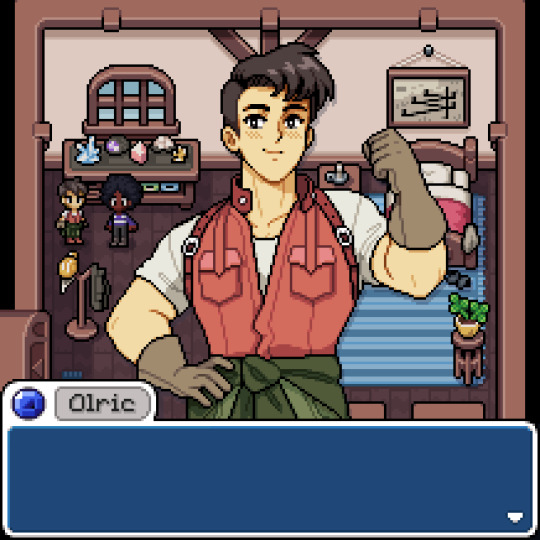
By this point I was kind of like "Okay, sign me up I am obsessed."
I grinded through the game, passing out at 2am frequently because I was not used to daily time limits, and completed the storyline to open the mines (Which I was most excited to get a look at).
Going in the first levels were copper and ruby, the perfect copper ore did look right which was exciting, but the game did fall into the pitfall of showing gems as, like, already faceted and not their normal crystal structure. Which bummed me a little, but I kind of get it (if I have to).
The next layer of the mines has a water theme and you can mine for iron and sapphires, (I have yet to get any iron ore yet so I can't judge it). I will pause and admit this game clearly is not going for geologic accuracy, so I won't judge it based off what you are finding together.
I am just infinitely grateful that geology was even mentioned, that people aren't mining just for the money but have a general interest in it. I feel like most games just overlook it, so for that I thank you Fields of Mistria team!
Regardless of everything, before I say what I wish this game does have I want to preface by saying I was never upset while playing the game and I will continue to love and play this game and I will recommend it to just about everyone I talk to
What I wish this game had:
-Ore stones that were more accurate looking, it isn't like ore doesn't look interesting (malachite I am looking at you) I know they were probably trying to stick with a color theme, but even rubies are found within zoisite sometimes which is also a green rock.
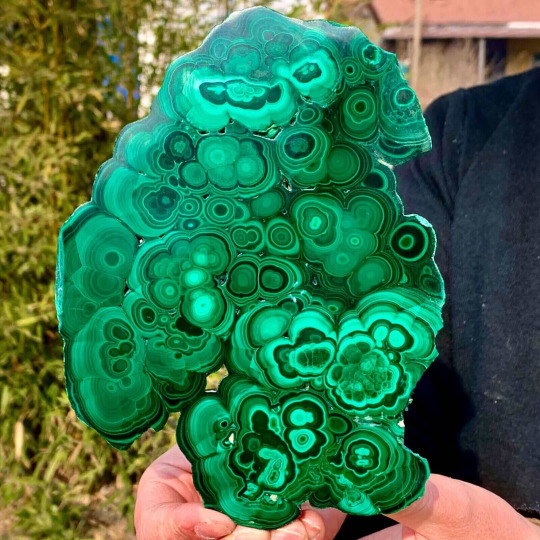
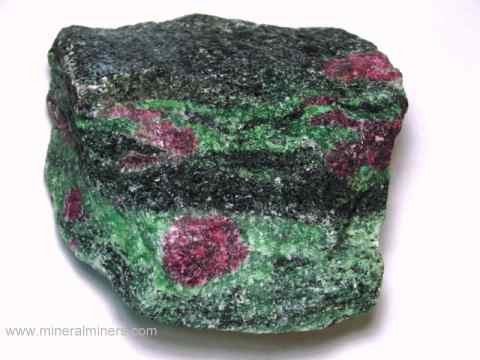
-Accurate gemstone crystal structures, I desire it, especially when I see them using quartz crystals in other locations, like I know you are capable
-I admit I am not far into the game yet, but we have characters that are clearly interested in geology, I would love a side plot where we explore the geology of the area, just as we do with archeology. (It deserves the love)
-I want to display my gemstones and stuff in my house too!
Anywho... It has been awhile since I posted about a videogame I think, It has been nice! I am thinking about getting Rika on release, so more videogame posts might be incoming, both on Fields of Mistria and Rika. I might have to get Stardew also because I just looked something up and you can... BE A GEOLOGIST??? I think I really was sleeping on farming sim games...I will still post my writing content too, I have one in the works I just have been lazy about writing it.
32 notes
·
View notes
Note
Hey, I loved your workshop for creating magical crystals-post! One of my worldbuilding project has magic crystals as an important part of the world, and I was wondering if I could pick your brain on how to give them colour.
These crystals are magic batteries, and rarer variants can hold more magic. Their rarity is indicated by their colour, going from yellow, least rare, to magenta, to deep blue, to viridian and eventually to a silvery grey, the rarest.
The problem I'm running into is that I'm finding that a lot of these colours are often caused by metal impurities, but I've established a rule in this world that metal hinders magic. I especially can't use iron because it doesn't occur naturally in this world.
Hello,
I think this is a really interesting concept for a magic system and I think the perfect answer you are looking for is the concept of 'color-centers'!
A color center is when there is an unpaired electron that is within the crystal lattice of a mineral. When this electron is exposed to light, it becomes energized, and produces a color we can visually see.
There is a lot more that goes into this, but that is the most basic version of it.
In a magic system, however, you can just replace the idea of an electron with magic, and, to explain the variation in color, you can employ an explanation like "the more magic present in the crystal lattice distorts the absorption of light into the gemstone changing the color." Effectively with this explanation you can create a way to determine how charged the gemstone is based off its color after using, and provide an explanation of why the color was present in the first place.
In the real world this is something that kind of happens too, fluorite is a mineral that can be colored from a color center, and when left in sunlight too long it will actually lose color.
9 notes
·
View notes
Note
as a volcano guy, I'd love for you to go over what media typically gets wrong about volcanoes (like people outrunning a fucking pyroclastic flow and/or surviving in it for any period of time). I know you sort of talked about eruptions in your natural disasters post, but I still feel like there's a lot to explore about the typical "stratovolcano that somehow has constant rivers of lava" image that most people think of. Some stuff about how karst caves work/different types of them would also be cool!
Apologies for replying so late, but this is so true and frustrating! Media does not really properly convey natural disasters, maybe to make people feel less scared? But what it actually does is give everyone false confidence, or allows people to make uneducated decisions!
So lets talk about it! First lets look at some things in media that upset me:

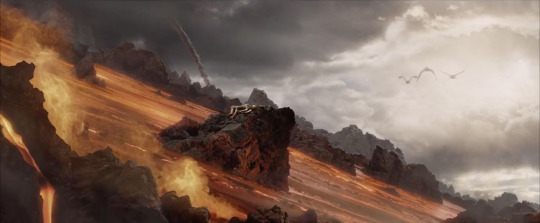
To be completely clear here, I love Lord of the Rings and so does my advisor, so at LEAST two geologists have managed to get over this scene. However, when I put on my geologist glasses there is a lot to unpack, first, the above volcano is a stratovolcano, which erupts how it is depicted above kind of, which means its letting off mostly ash and giant boulders, and! the lava is not that flowy. Only mafic lavas flow like that (like in Hawaii). Stravovolcanoes get their shape from all the ash that is shed down the sides of the it, that is what the volcano is made of!

Also, even if we want to play devils advocate and say, "ok they got lucky with pyroclastic flows" WHICH GOES ON AVERAGE 60MPH OR 100KM/H. And lets imagine that these rocks just managed to keep them cool enough to sit on that rock, lava releases toxic gases?
Like CO2 which is toxic by itself sure, but also sulfur dioxide, carbon monoxide, and other very very toxic things.
Another thing about pyroclastic flows is they are freaking hot! 200°C and 700°C (390-1300°F) the heat will kill anyone before the ash does.

And now that I have brought up ash lets talk about what it is because people just casually standing in it with no masks?

Those are tiny glass shards you are inhaling, you know how asbestos is super bad for you? This is just as bad for the same reasons.
Dropping media for a minute, volcanoes kill in several different ways, whether it is an incident like Pompeii which was overtaken by pyroclastic flows, whether is be from volcanic gases like the Lake Nios, or from related earthquakes or tsunamis caused by the volcanic activity.
Speaking of Tsunamis!

No, there is not some huge wave, more than likely you will not see a tsunami coming. The most you get is maybe feeling the associated earthquake or volcanic eruption, or you see the ocean receding rapidly.
YOU DO NOT NEED TO BE BY THE EARTHQUAKE OR VOLCANO FOR YOU TO BE AFFECTED BY A TSUNAMI, If something causes a tsunami to happen in Japan, it can also affect Hawaii, and the West Coast of the US, and visa versa. This occurred most recently (to my knowledge) in 2011.
Do you want to know how fast tsunamis travel in open water?
over 500 mph (800 km/h)
Media should have some responsibility in teaching people how to behave in these situations to some degree and natural disaster safety should be taught regardless if you live in Kansas or Washington state, because who knows where you will end up living as an adult or if where you happen to vacation experiences a disaster.
I know there is a lot more to address from a lot of movies, but if I am being completely honest I avoid movies involving natural disasters like a plague because it just leaves me feeling very upset.
Oh wait one last thing to everyone seeing this!
YELLOWSTONE IS NOT GOING TO ERUPT. STOP SAYING THAT. The rhyolite magma chamber beneath Yellowstone is only 5-15% molten (the rest is solidified but still hot). Pick another volcano to start an apocalypse, because she ain't it.
Oh, also you don't need a supervolcano to send the world spiraling, a year without a summer, which was an absolute disaster, was created by the eruption of mount Tambora (in Indonesia) and just in EUROPE over 65,000 died because of the climate changes and resulting famine.
Thank you for your time!
#geology#rocks#stem#science#fictional world#media#movies#yellowstone#volcanoes#i don't even know how to tag this so people see
45 notes
·
View notes
Text
Writing a Geologist/Someone who studies rocks: From a Geologist
Maybe a bit of a personality analysis on myself and everyone I have studied/worked with thus far, but I figured it would be helpful to provide the more common types of geologists, what they might find interesting specifically, and how they are conducting their research. I also wanted to show different sides of geology, because most depictions are of this rugged field geologist who always wants to go outside, when that is only like... 1/3 at most of the geology community.
Anyway! Let's get into it! *Also let me preface that this will be about geologists that have stayed in academia and not a geologist working a 9-5.
*I put bullet points at the bottom for people who don't want to read all of this*
There are probably three MAJOR types of geologists, but of course we are human and our interests lie somewhere on a spectrum. I just wanted to give the 'generic' versions to make it easier for you to write a character.
The first kind of geologist is the field geologist!

I am once again really just yoinking someone's face again, sorry stranger. I feel like this is a great image of someone doing fieldwork. So, what they are using in this image is a 'Brunton Compass'. So what is different and important about this compass compared to others is that it can be used to measure the angle the rocks are sloping, used to measure elevation and a lot of things honestly, but what the man in this image is doing is measuring the angle of these rocks for geologic mapping purposes. A lot of these geologists ask questions like: What did this landscape used to be? How old is this? What lived here during that time? What was the climate/temperature at that time? How has this changed since it was *insert what it used to be* and what changed it?
Some things I have noticed a lot over the years when dealing with field geologists is they can hike... endlessly. They never seem winded going uphill and those boulders that seem dangerous? They are in them. Heights do not seem to scare them at all, in fact nothing scares them. Camping for extended periods of time is one of their favorite things, and ending the day with a beer is kinda their thing. They are some of the friendliest people I have ever met also. Super, golden retriever energy. (of course every once and awhile you will find a mean one though)
Next on this list is the classic lab rat geochemist/petrologist. (I am a geochemist/petrologist in practice so I can say this, though this is less a description of me and more so some of my lab mates, yes I am outing them).
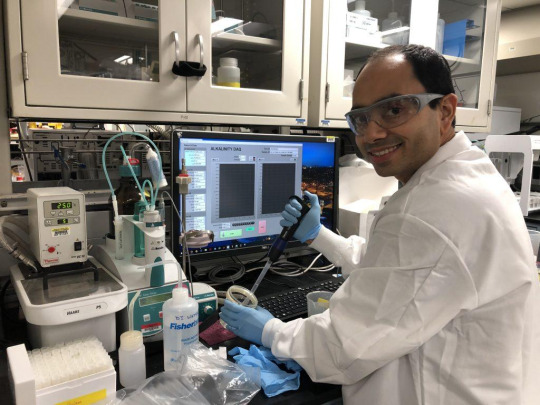

Thank you for your service random strangers! These are a type of person that really care more about the rocks after they are dissolved and run through a machine to give results. Things they love: strong acids (How else will you dissolve a rock), machines that will explode if you turn them on wrong, excel spreadsheets (we actually hate them though). All joking aside, Typically what these people really like about geology is being able to understand the 'life' the rock had. What did this rock used to be? What does this represent? How has this rock changed and evolved through time? With these elemental changes, what does that imply of the process this rock experienced?
You might be thinking to yourself now "how are these different from the questions listed for a field geologist?" and to that I think I would say scale. I think in general a geochemist looks at things that are smaller but can have bigger implications and a field geologist looks at the big picture. Its important to note that most research is always best when these two are working together. And when you think of it that way you can create some fun interactions with these two characters.
Personality wise, I feel like its all over the place, I have met several nice geochemists and bunch of not so nice geochemists. A geochemist will more than likely have a rock collection, but likely it will be of rocks they do not study. They will pull long nights at the lab and I feel like they will always be reading about something they 'just don't quite grasp' while critiquing or complementing the paper. Most geochemists still like to get out of the lab every once and get some fresh air, (they chose to study nature for a reason), but they don't do it enough.
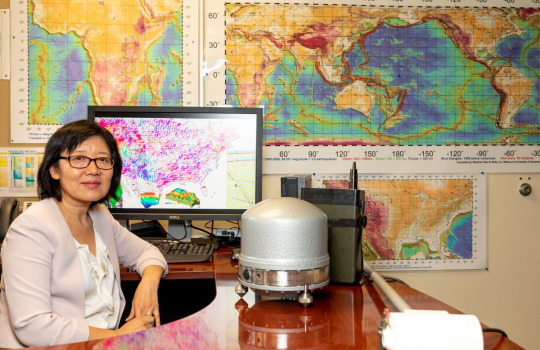
The last kind of geologist is a modeler/geophysicist, these guys! These guys... I don't know a lot of them, I know a couple. So my understanding might be skewed incorrectly. Let me know!
Anyway! Geophysicists can be interested in earthquakes sure, it is important to know what is causing these major disasters, but most of the time (not every geophysicist uses earthquakes, this is just an example) they are interested in what they can learn using earthquakes! which is really so crazy! So, what a geophysicist will do is study how the waves more through the earth, because waves travel at different speeds through different solids and liquids (some waves don't even travel through liquids). Soooo, what are they curious about? The mantle and most importantly, the CORE. Yup, cool stuff. Anyway why did I include modeling in this also? Because using these observations typically you would make a working model to better understand how the system works. Models can also be made for fluid movement in the earth, volcanics, and a ton of other things, but the work is similar to that of a geophysicist. This is very big picture stuff, trying to figure out how the earth works in general. Also the key here is, from my understanding, it is a lot of math and a lot of coding. Which actually means a lot of people from those backgrounds find geology later in life.
Geochemists and geophysicists often work together and could potentially have a very good or very bad relationship.
Personality wise, these guys are always on a computer honestly, sometimes they will be stuck waiting for their model to finish running for days at a time. Just like a geochemist, you will find them outside occasionally, maybe to put in a new system, but more than any other geologist I feel like modelers are exceptionally good at not making their job their hobby. They may do martial arts, art, baking/cooking, owning plants, etc., on the side much more than the other geologists. These people are super smart, but these folks are probably the ones who know the least about like 'generic' geology, as in mineral ID and stuff, but they seem very nice and are typically pretty introverted.
There are many other kinds of geologists, like the geologist who kinda wanted to do marine biology but there were no jobs in marine biology so they study the ocean floor OR they studied paleontology of oceanic critters, so they could backdoor get into marine biology somehow and many others, or geologists who study the surface as it is today, but now lets talk about how all this can be helpful with writing.
I am making a bullet list of things that will apply to your character A=All F=field geologist P=petrologist and geochemist and M=Modeler and Geophysicist
A: It is important to know that one person cannot fill all of these roles as a character, and it is okay for your character to say "that's not my thing, but I have a buddy".
A: Feel free to make your science character have a very specific interest, not only will it probably make it easier for you in terms of research, but it is also more realistic.
F,P: Your character is likely to point out things that your other characters might not notice while walking, especially if they are a geochemist and field geologist. It will just be small comments here and there, like "Oh! Is this basalt?" before they might amuse themselves examining the rocks (It is a good way to get rid of the character)
F,P: There pack will be full of rocks, you will try to pick up their bag, and it will be exceedingly heavy
P,M: You are likely to find them crashing in their lab/office because they worked too late
F: They will drop everything for an excuse to go outside for 'vacation' but they will inevitably do geology the entire trip.
P,M: Probably behind on reading, and probably have a migraine from staring at too many screens.
P: Unsure if their hand is itchy because of dry skin or if they accidentally got acid on their hands (Some acids [HF] don't immediately burn your skin).
M: Always harassed by the scared general public because of a small earthquake that happened where is 'shouldn't have'.
Anyway! If you have anything geology related that you would like me to write about please feel free to ask! I am running out of ideas for my writing guides and am probably going to switch to different content soon!
#geology#rocks#stem#science#creative writing#fictional world#worldbuilding#dnd#writing#writing resources#writeblr#writing reference#writing research
27 notes
·
View notes
Note
Hello, I was reading through your posts and couldn’t help but be inspired for a fictional material by some minerals and metals having an effect on the surroundings. If it’s not a chore, could you please provide any real world examples of how some minerals have effect on the environment. Something like affecting the structural integrity of, dyeing, or any other effects on the surrounding rock. Apologies if the question is not well worded or I’ve made an incorrect assumption, I know nothing of geology myself :)
Boy, I am so ridiculously happy you asked me that! It is one of my more favorite subjects! I will break this up into three sections, first to talk about environmental effects (this will include ideas of like mountain shapes, natural disasters, contamination of water, and even how streams look), then we will talk a bit about industry (what minerals are used for what, and how do they effect the people using them), then I will talk briefly about infrastructure before directing you to a documentary series that is old but does in fact explain all of this far better than I ever could hope to. This is kind of an extension of my economic trade and mining posts, so I will try to talk about similar but not the same topics! I feel like for the best results they should all be read together!
Environment: Some minerals that occur naturally are incredibly unstable at the surface, and when they breakdown it can really harm the environment. I am originally from Pennsylvania and a big problem in that area was something called Acid Mine Drainage, which is, in the simplest words, when sulfide minerals (in PA's case, pyrite) break down and lower the pH of the soil and water. This effectively kills most things living in the environment and can even be strong enough to cause skin irritations.
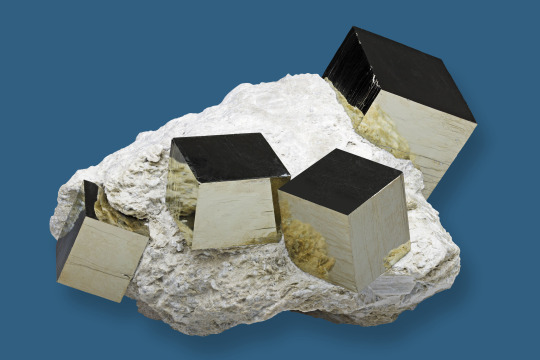
A great idea in a fictional world may be an old mining district that was abandoned and rediscovered with toxic water.
Something else that is small and thought about much less probably is something that happens when you boil water. If you pull well water (or groundwater) and boil it something that you may notice is a white ring form around your pots and pans. This is because your soil or rocks have access calcium and when you boil your water it precipitates out. This is not harmful, but it is something that will vary based off locations, and could effect ones health in a positive way (calcium is a very important nutrient).

But taking a step back from human health, lets look at large scale differences that can be effected by minerals/different types of rocks
The first thing to consider is how can a landscape look? typically when you have metamorphic(excluding schists) or intrusive igneous rocks (granite and whatnot) typically you will see doming, well-rounded mountains vs. sedimentary rocks where you might see distinct layering as some layers are more soft than others.
More mountainous locations, regardless of rock type will have more braided rivers, and places that have lower elevation change will be more meandering rivers. The bottom of the riverbed also changes! in older mountain ranges you would expect to see more metamorphic rocks exposed to the surface as the top of the mountain range has already been eroded, while fresh new mountain ranges might have a larger diversity of rocks within the river. Something I distinctly remember from going to North Carolina for the first time was seeing all the glittering mica in the creek beds there because the Appalachians are a very old mountain range.
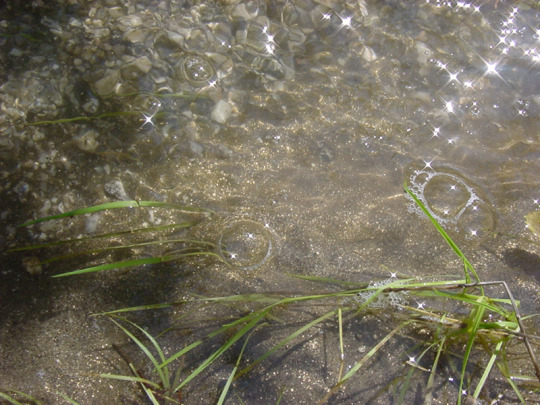
Always remember: The rocks in the river reflect what is in the mountain!

But how can this effect how does this effect people? crystalline rocks are typically safer mountains to live in than sedimentary rock mountains, because they have very little variation and are less likely to break across planes of weakness, that said they are usually poorer in resources for older time periods other than for making things like stone for building houses and harvesting silica to make glass. There are of course exceptions to this, but for the most part this is true.
Sedimentary rocks mountains on the other hand are more dangerous in causing landslides and sinkholes, however they are usually rich in resources like clay, coal, oil, and even in some causes be rich enough in metals to be mined for iron. Chert is also a sedimentary rock that is used a lot in Native American cultures to make arrowheads, spearheads, and basic cutting tools, though this is way out of my realm of knowledge.
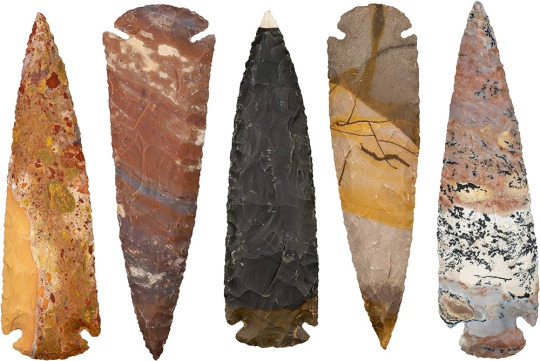
Industry: I have already hinted at some of these but I will try to talk purely about different things in this section! First lets talk about lead, my Roman empire is the Roman empire collapsing due to lead poisoning. Galena, a lead sulfide, is a rock formed in some sedimentary rocks and in hydrothermal environments (hot water injecting into cold rocks), hydrothermal activity can be present in past volcanic environments, during metamorphism, or even on the ocean floor. These are accessible in many locations is what I am trying to say, and lead is VERY appealing until you know it poisons you. It has a very low melting point meaning it is easy to work with, it is resistant to corroding, and it even imparts a sweet flavor and was used during the Roman empire to sweeten food without the addition of sugar or honey. Later, it was used due to its white color to make one look paler than they truly were because staying inside was a status symbol, added to glass to lower the melting point and increase the time it could be 'worked with' and the added side effect was that it made glass more shiny which then made it popular in jewelry. Lead was also used in paints, and dozens of other things, but it is time to move on.
Lets talk about paint colors that were available based on rocks! Clays and sedimentary rocks typically contained red to yellow hued pigments (think rust and earthy tones), so those colors would be seen more in art in areas dominated by sediments than say, green (unless there is a plant that can produce a strong enough pigment). Metamorphic rocks/hydrothermally altered rocks are more likely to produce colors like greens and blues and vibrant reds. What creates these colors is usually copper and mercury will create vibrant reds.
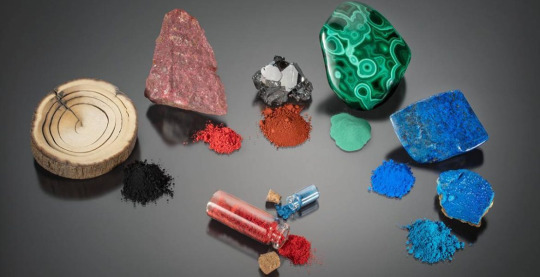
Scheele's green was a popular green that was created by an arsenic-bearing mineral that killed many people during the Victorian era.
Let's also briefly talk about how rocks could effect cosmetics! glittery eyeshadows, highlighter and other things we use today often use the mineral mica, which is a metamorphic mineral. It stands to reason that having shimmery makeup trend would be more likely in places that could supply it. Chalk could also presumably be used as a cosmetic which is a sedimentary rock, so maybe they could value matted and paler looks?
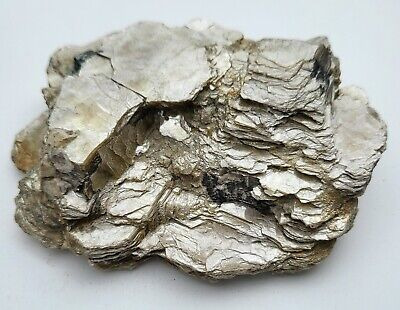
Another random thing that I have been dying to mention but couldn't think about a post it would fit in but imagine asbestos clothes that was a thing! Obviously people didn't know that it was bad for you at the time, and it seemed a miracle because it would be unaffected by fire and it was FABRIC made from ROCKS. Again, this is only found in places where asbestos is found, so like low temp metamorphic mafic/ultramafic rocks (essentially take the ocean floor and heat it up a little and BAM asbestos).
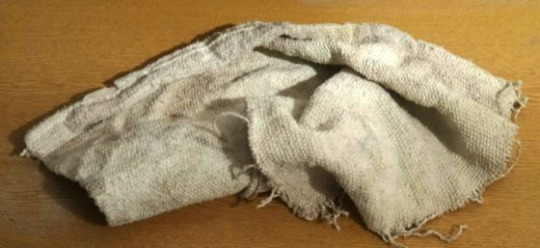
anywayyyyy, I truly truly believe the results are endless in this regard. I know very little in terms of history, so I am sure there are many others that can add to this in a very significant way.
Infrastructure: This one is probably the most obvious, but in terms of strength in building, different rock choices will be chosen. There is a reason marble is used to make pillars. Though the general rule of thumb is that massive rocks are generally more resilient to breaking, this includes sandstone for sedimentary rocks, granites/diorites/gabbros for igneous rocks, and marbles and quartzites for metamorphic rocks. Foliation or layering in a rock can also be abused like using slate for shingles and chalk boards and schist also for roofing.
The documentary that talks about most of these things: Journey to the Centre of the Earth: Art and Journey to the Centre of the Earth: Architecture. It is an older documentary series but I genuinely love Ian Stewart and all of his geology documentaries. You can also find both of these for free on YouTube I strongly recommend you find a legal version of this!
Anyway sorry for replying late my work has been piling up lately! Feel free to ask anymore questions! Also I didn't proofread this so if there is any grammar issues I am sorry.
28 notes
·
View notes
Note
From one geologist to another, hi! Love your geology video game posts btw
Oh my gosh! Thank you so much, and hi! I really love writing about videogames but I feel like I haven't been playing enough of them lately to keep up with the posts but this is still so great to hear. Let us hope a great videogame comes out with some great geology!
8 notes
·
View notes
Note
I saw the landslide stuff and one thing i have not seen in person, but seen videos of and in smaller cases after effects of is this one type of Clay, that normally is solid, But can kinda suddenly become liquid, taking entire landmasses with it. A barn near where i lived ended up going into the nearby lake Due to the clay being disturbed by something new getting built there, and therefor suddenly liquefying, taking the barn with it into the lake. Quick clay i believe it is called? Terrifying yet really interesting.
Quick clay is certainly a kind of clay that is notorious for causing slope failures, but clay in general a very common 'plane of weakness' that can allow for landslides to occur, and I feel like it makes sense when you think of the image of someone throwing something on the wheel, it is incredibly malleable and adding any amount of weight to it may lead to failure.
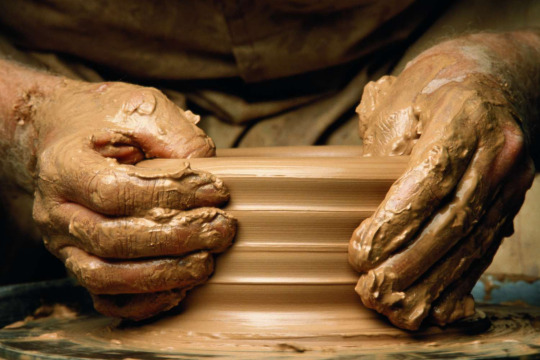
But this is a good first hand example of a disaster that can happen with seemingly no rhyme or reason!
Another good example of a natural disaster that can feel semi-random but is typically disastrous for the people experiencing it is sinkholes! If you live in an area that has a lot of limestone, sinkholes are a fairly common occurrence as the ground slowly dissolves with the rain and can lead to eventual failure!
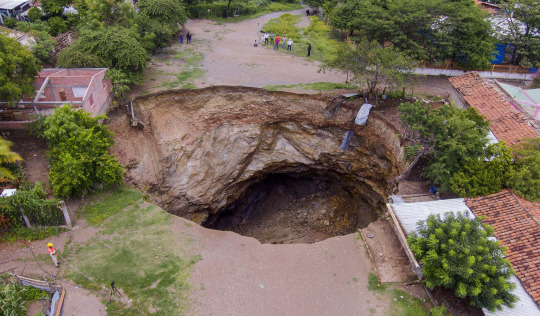
14 notes
·
View notes
Note
may i receive your rant on why every videogame ever chooses to have columnar basalt in places basalt should not be, like in unsuspecting caves or just dotting beaches with no volcano in sight... because god, that gets me going.
Let me preface this rant by saying, I love when videogames at least try, like I can look at a rock and actually say, "hey that's columnar basalt and not *generic rock texture*" (Pokemon Scarlet and Violet's texture shortened my lifespan). So generally speaking, if I can tell at least vaguely that someone googled photos of rocks when creating a game I am more happy than not, but!
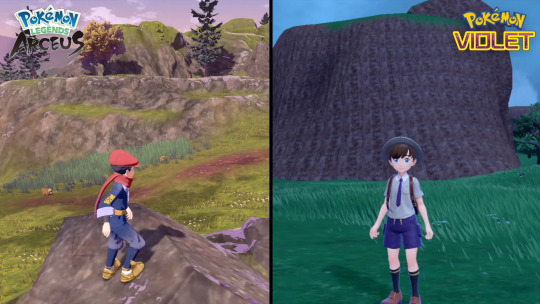
My GOODNESS! I think I could extend this rant to just videogame cave systems in general! Like, caves are only formed in limestones and marbles (And some limey sandstones and salt deposits), BUT for some reason we are mining and finding Rubies? Emeralds? Metals? These caves they are depicting are clearly just supposed to be these natural caves and not abandoned mines, which would give them some leeway to put whatever desirable gemstone or ore they wanted in the game, but they don't choose that for some reason, and it is beyond me why!
And can we talk about how all of these caves got there in the first place? Like limestone only forms in marine environments! Are you telling me that the entire continent you designed was underwater to the extent to have a spiraling cave system forming at least every ten miles of trail explored (Skyrim I am looking at you)? And how acidic is your rain? Are we experiencing an industrial evolution? I CANNOT, also in what situation are these random massive quartz crystals in otherwise fine-grained material forming? Like one, Who would actually leave that laying there? No one. And two, how is this forming? Like are you trying to say this formed after the cave was created or what? If that's the case the more likely mineral would be calcite or gypsum.

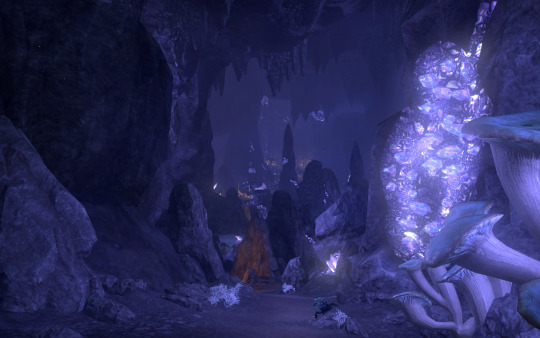
My little bird brain can't wrap my head around what they are trying to do here! (The second image is from ESO and I give it a lot of lenience and to be fair they are trying to depict these are geodes that are surrounded by a massive basalt but they are also showing stalactites and stalagmites which aren't in basalts so it still gets points docked).
But yes! Seeing inaccurate geology, columnar basalts included can take you out of a game so fast, same with the imaginary ores that are kind of based off real metals. I think I would be more ok with completely fake names, because then at least I wouldn't have anything to associate it with.
That being said! I will end this rant by pointing out videogames that when either I was playing or my fiancé was playing I was pleasantly surprised by the geology/accurate textures.
ESO- elder scrolls online, I know I just docked it points above, but genuinely they do an amazing job depicting different rock types to the point that on their islands they have limestones. with. fossils. I nearly cried. Of course they still have random metal seems everywhere but it is an MMO and resources are necessary so I can ignore that as long as they keep making accurate landscapes.
Titanfall- I will just add an image because it will speak volumes

like does that shale/siltstone have ripple marks in the middle right hand side? beautiful. amazing. perfect. chief's kiss. (Apex also does a decent job which is a battle royale game that takes place after the Titanfall games, the textures aren't as good obviously but you can definitely tell what kind of rocks are at each map)
3. Horizon Zero Dawn- the graphics in this game are just genuinely impeccable and it takes place in the US but after the collapse of civilization. In a lot of ways, I think it made it a bit easier for the designers, but they still did an amazing job depicting the rocks accurately! I believe there is a Youtube video which compares the actual locations to the videogame locations.

some obviously tilted sedimentary rocks
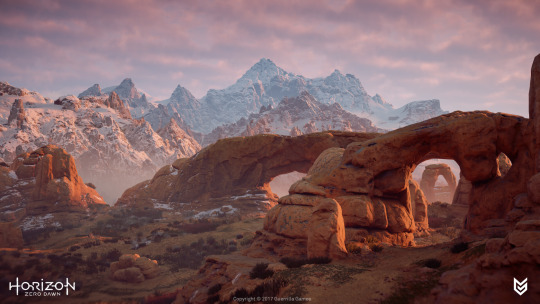
sandstone arches
@cosmic-tuna please add more games if you know any!
36 notes
·
View notes
Text
A Workshop for Creating Magical/ Fictional Crystals: A Guide from a Geologist
Hi folks, its me, here to talk about fictional writing again! Today I'm just tackling the idea of magical stones/mana stones by looking at existing minerals today and some neat properties that they have, and how you can apply these things to a fictional world. The goal is mainly to help you if you are stuck trying to come up with a unique magic system, or a unique identification/characteristic of your mineral.
First Things First: Mineral Shapes

I am exhausted, petered out, down-right fatigued by seeing every mineral depicted with having the crystal structure of calcite and quartz. There are soooooo many cooler, more interesting crystal structures, don't you think you would stop and take a look at a perfect cube in nature? It is completely unsettling.
Second: Color
Color within minerals can either be really important, or not important at all! It is your choice to decide if color is going to be something that means something to your mineral. But what are some times when the color is important? Well.... there are some elements that are called chromophores, this classification just indicates that these elements, when present, will determine the color of whatever they are in. So, if you wanted to treat mana like a chromophore, you could say, "Oh everything that contains mana turns green!" This could mean that regardless of the mineral, if that mineral is a specific color, it means it contains mana. This concept is exciting because you can just stop here and use minerals that already exist! You can also use it as an indicator for a magical ore! Chromophores are typically metals, so if you are making a new metal weapon, making the ore of that metal a unique color would make a lot of sense!
However, your mineral can also just be every color of the rainbow like quartz and perhaps that's what makes identifying your mana stones elusive and create an illusion of scarcity that your character can solve.

There are other things that can change the colors of minerals, like radiation damage, and electron exchange, but I think that is beyond what would be helpful! So lets talk about some unique color properties that happen in nature that seem magical in the first place! Maybe you don't need to design a mana stone, but you want a unique gemstone that only the royal family passes down or something (IDK).
The first one is the alexandrite effect! This is where a mineral can change color in natural light vs. incandescent light. (the mineral itself is not changing, but the lights contain different amounts of different colors that then get absorbed by the stone). Even if you don't use electricity in your fictional world, you could have the colors change in the presence of light magic. This could create fun misunderstandings about what the mineral is reacting to!
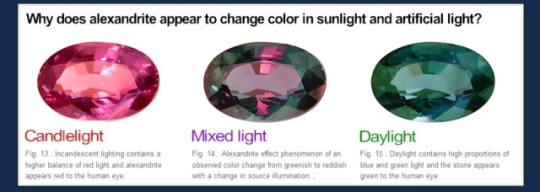
Pleochroism
Pleochroism is something that most minerals have, it is frequently used to help identify minerals in thin sections, however minerals are usually not pleochroic enough for it to be visible to the naked eye! Pleochroism is just a fancy name to describe the change in how light is absorbed based on the angle of the mineral! So if you scroll up to the first image where I showed a lot of crystal shapes, most of them have angles where they are longer and shorter! This will effect the way light travels in the crystal. Tanzanite is a popular mineral that does this.

Photochromism
This is when a mineral will change color (in a reversible way) when exposed to UV light (or sunlight), I am not going to go too into the details of why this is happening because it would require me to read some research papers and I just don't feel like it. The mineral that is best known for this is Hackmanite!
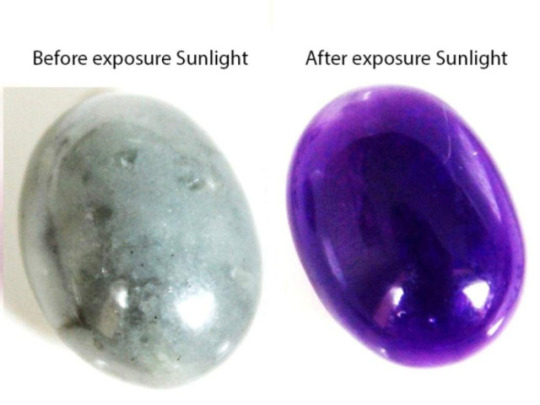
Alright! These are all the really cool color effects that might inspire you or maybe not, but now I am going to talk about how you might find your minerals within a rock!
When I see a lot of magical caves/mines, typically I see them with some variation of a geode honestly, but most minerals are not found like that! Now I am sure most of you guys have seen a geode, so I will not really talk about those, but I will talk briefly about porphyroblasts which is when the mineral grows larger than the minerals around it, this happens in metamorphic minerals!

sorry random stranger, but this is an image of garnets inside a finer-grained rock at gore mountain in New York!
Another way you might find minerals is in a pegmatite! This is when all minerals are really large! This is a formed from really slow crystalizing magma!
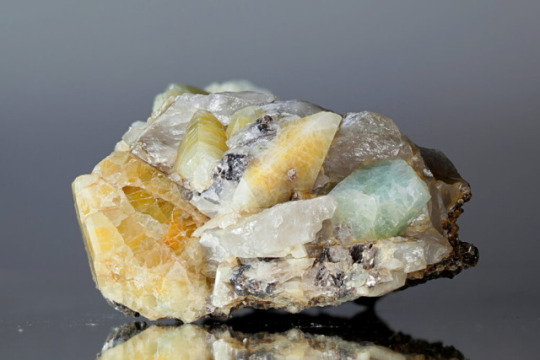
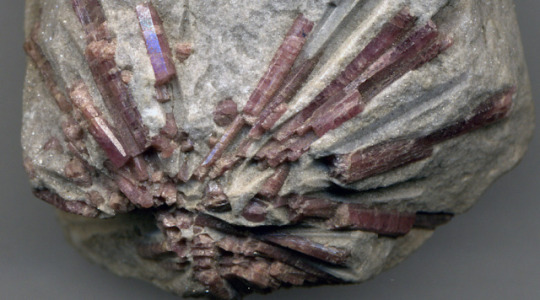
But something else to think about is that your mineral might just be massive, it doesn't have to have distinct crystals, it may be similar to jadeite where small grains grow together which leaves it looking smooth and seamless! A note about all of these is that you would have to mine into the rock to find these, there would not be any natural caves in these rocks! Caves are only ever really formed in limestones and maybe marbles (rocks that react with acid).
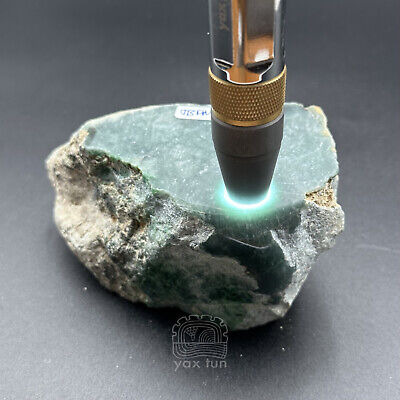
How can your characters identify these minerals?
Typically when you are out in the field you will look to see what type of rocks the minerals are found in (The overall texture of the rock will tell you how it formed). If you know how the rock formed, it will narrow down the amount of minerals you need to think about by quite a bit! Next, you are going to look closely at it and observe its crystal structure, does it have an obvious crystal? if so what is the general shape? If it is broken, how did it break? Did it fracture like glass or did it break along uniform planes. Some minerals have a thing called cleavage (breaks along planes of weakness). If a mineral exhibits this habit, it will again help narrow this down. Next we can look at color. Color can be misleading, because minerals like quartz can be any color imaginable, but minerals like olivine will always be green! The next thing your character can do is test for hardness, minerals all have a specific hardness that can help identify it as well.
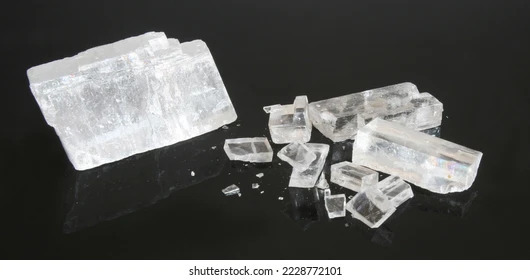
After you go through all of this, your mineral might have some special property! This could be magnetism, fluorescence, reactions to acid, or any of the color changing effects I mentioned above! Other than that, your character can take it back to a lab and do a number of things to identify it, but the most typical thing would be for them to make a thin section (very thin piece of the rock) and observe it under a cross polarized microscope!

On that note folks! I hope this helped in some way in thinking of new magic mineral properties! I have other guides that explore some different fictional worldbuilding issues you might run into, but if you have any topics you would like me to cover please that I haven't mentioned already, let me know!
#geology#rocks#creative writing#fictional world#worldbuilding#dnd#dnd worldbuilding#worldbuilding stuff#writing resources#info post#information#writing
6K notes
·
View notes
Note
Hey I was wondering if you could help me identify garnets from an old animated film?
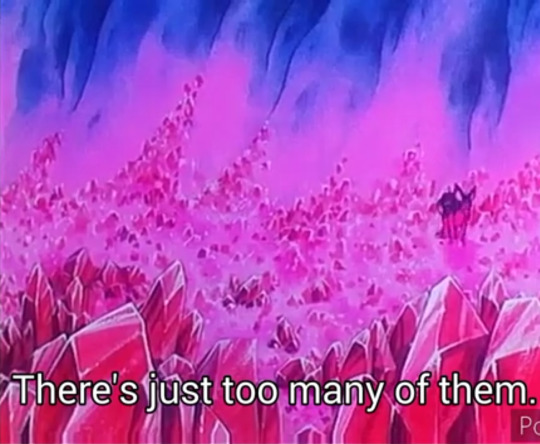
I've no idea if the creative team used any real life reference for this (despite my knowledge of films vastly outweighing that of geology)
Hello! Thank you for asking, as I am actually going to make a post a little into the future addressing crystal-shape because I have seen this issue a lot in media. These are not garnets! Garnets have a cubic to rhombic dodecahedron crystal shape, which means that they are going to be more cute, chubby, and round!
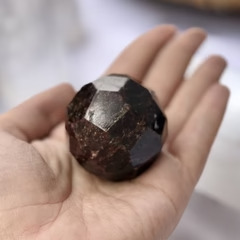
Colors of garnet can vary depending on what elements they can substitute in their crystal structure, so the one above that I am showing is most likely almandine which is an iron aluminum garnet, which tends to have a deep red color because of the ferric (oxidized) iron, but other colors garnets can be range from green, orange, pink, and many different shapes of red. So at least the color seems accurate.
I do have one final aside from this over analysis of this image and its that garnet is typically not found as a geode like quartz, but as a porphyroblast in metamorphic rocks! This just has everything to do with the conditions necessary to form garnets (Which like high pressures and temperatures) vs quartz, which can thrive in most conditions (Its a weed essentially).
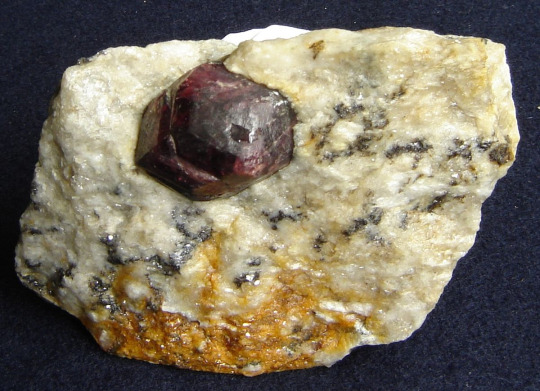
I appreciate you willing to let me stand on my soapbox and preach about garnet, as it is both my best friend and my enemy in my working life. But in all honesty, there are a lot of neat crystal shapes that exist and I just don't seem to see them enough, as everyone always has the preconceived idea that 'crystals' look like quartz crystals because they happen to be the ones that people see the most due to how common and cheap they are (Which is not their fault).
11 notes
·
View notes
Text
Writing about Mines in your Fictional Universe: A Geology Introduction
Hello! I'm Bird, and I am here to guide you on a journey about different mines that exist, what materials are being mined, what those materials might be mined for, and what rocks/what processes might make these areas mineable. I will also touch briefly on the idea of gem quality, the commonness of the material, and what these things might look like fresh out of the dirt!
First things first, lets talk about the what types of things we might want to mine for in a fictional universe! There are a lot of things that are used daily that require mining, but there are a few that I see written about the most: Gold, Gemstones, Iron, and Coal. I personally would love to see this idea expanded on a bit, so lets talk about some mines that would definitely be necessary but overlooked! First one is pretty easy, glass! those beautiful stained glass windows are useless if no one is mining quartz to be made to glass, and I imagine it would be quite a profitable business seeing as glass, in general, was a luxury in ye olden times. The next thing we need to address is Abrasives! want to sand and polish stone and metal? Want to sharpen your blades for battle? May I introduce you to abrasive minerals! garnet, corundum (Ruby and Sapphire), and yes, diamond! Why are we using such beautiful gemstones to polish other things? Simple, even if you are to find a deposit of these gemstones (garnet being one of the more common ones) most of the time they are inclusion rich, ridiculously small, an undesirable color, or all three of these.
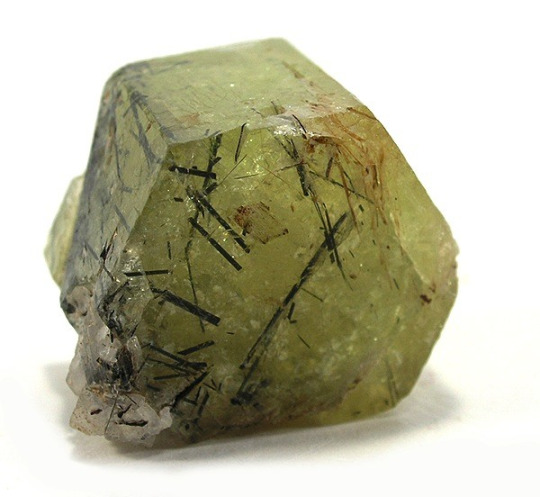
Finding gemstones that are good quality is hard, your character will not stumble upon it, pick up the rock and immediately know if the location is good enough to mine gemstones. If you are determined to make it a gemstone mine, have your character hold the mineral up to the sun/a light source and let them be able to see light coming through, though it is considerably thick.
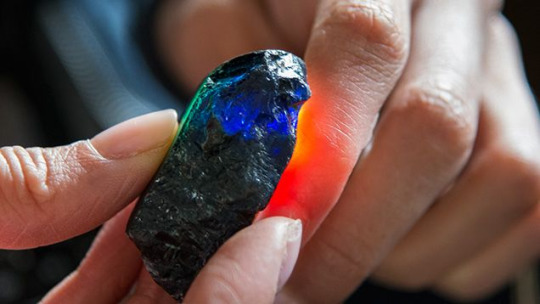
Moving into metal mining! Metal mining is both easier and more complicated to write! Why is it complicated? Because unless it is gold or silver you are unlikely to see the desired metal itself. Why is it easy? welllll, I am going to try to make it easy. First things first, a lot of metals are chromaphores, this means that when the element is present, it will influence the color! Copper is an excellent example of this, old pennies oxidize and turn blue/teal/green, so do most rocks bearing copper! Looking for iron? It will probably stain the rocks dingy and brownish red. Things to note: copper and iron can be found in mineable amounts together! If you do this, iron will be present in the form of pyrite, or fool's gold, this has a nice cubic shape and can be described as such, the copper will typically leave a teal residue or veining across the rock, which in this case will almost exclusively be black to dark gray (Its basalt) but it can be found as the mineral chalcopyrite also (looks like fool's gold but it doesn't make cute crystals). Malachite is also a copper ore, in my experience I have never seen malachite from a mine that has looked like some of the stuff I have seen in gem shops, azurite (A darker blue mineral) can be present also, but again, these are usually very fine grained and would not be able to be used as jewelry, but obviously, in some places it must happen, just much less frequently.
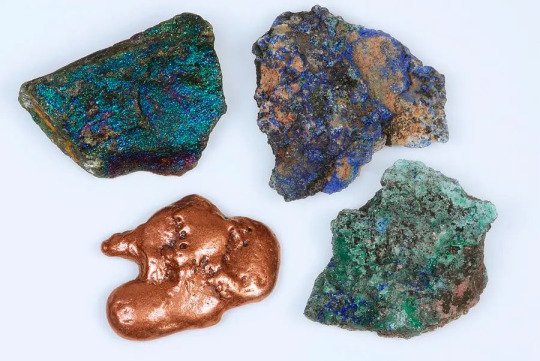
Another thing I will briefly mention is that, if you are writing about metals remember that these metals will require a smelting process to extract a pure metal, this usually requires some other material (For iron, it is charcoal). Also remember alloys! Most useable metals are a mix of different metals to make them harder. This even includes gold jewelry. Last comment about metals, a very interesting plot for a fictional universe would be the use of lead. Lead ore was a hot commodity before we knew it was toxic, the side effects (Being nuts) could really create some tension.
Lastly in terms of mined material, I will briefly mention coal and stone in general just to say, coal is a sedimentary rock, distinctly different from the typical environments necessary to form most gemstones and heavy metal deposits (Yes, there are exceptions). Coal is dark black/gray, which is quite uncommon for sedimentary rocks which tend to range from reds/tans/browns/grays. When coal is lifted it will feel much lighter than you anticipate, which is the polar opposite of what happens when you lift a metal rich rock, which will feel immensely heavy. Finally, Coal will not turn into diamonds in nature, diamonds need mantle pressures and temperatures to form, there will be no diamonds under a coal mine unless there was a mantle derived eruption that got covered in a swamp, that became coal and as they dug they exposed the kimberlite pipe (I mention this because I just read this in a story and it hurt my feelings). Finally, If you want to write about a mine that is definitely necessary but want the content to be pretty low-maintenance, but profitable for whoever owns it, owning a granite/marble/ or really any desirable stone quarry would be perfect.
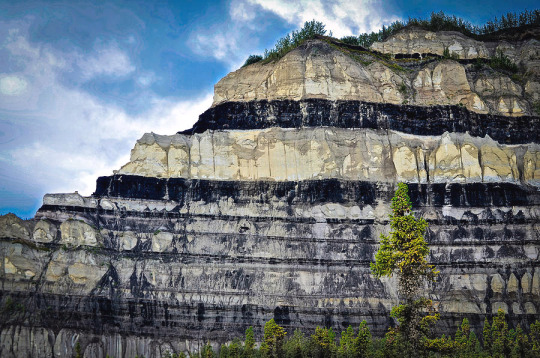
Now I will move onto what kind of mining exists today, I will not talk about every exclusive mine, but I will talk about ones that are common that are on my radar. First up, the one everyone talks about in books, underground mining. Underground mining is used when you are getting the material from the 'primary'/original source. The rock is rich in copper? Lets mine said rock. However, mining underground is the most dangerous form of mining, there can easily be a lack of oxygen because of insufficient ventilation (That's why people will carry something with an open flame when going into abandoned mines; if the flame goes out there is not enough oxygen and you have to turn back). There can also be lots of collapses due to overhead rocks, enough said. Cave mining is primarily done when the amount of rock above the deposit is too great to strip mine.

Now lets talk about strip mining! Strip mining is when you just mine on the surface, and dig deeper and deeper into the ground to obtain your desired resource whether it be stone, coal, gemstones, or anything else. It truly is less glamorous, but it is safer than digging a tunnel. That said it has its own issues, sure the oxygen is good, and you don't have to worry about the rocks collapsing over your head, but oh wait, the rocks can collapse over your head. Landslides can occur due to the over steepening of sides, excessive rainfall, and most importantly, old faults or planes of weakness that happen to be facing towards the mine (the diagram will help this make sense). Both of these types of mines can also create ecological damage, which can be mitigated nowadays, but then maybe not so much. Namely acid mine drainage, I will not talk much on the effects but a quick google search will give you plenty of information that might be useful for writing.
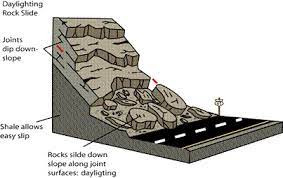
Now both of these are trying to mine a targeted rock, but sometimes its best to let nature do the work so we can do less. Diamonds, gold, corundum (rubies/sapphires), and garnets all have one thing in common. They are dense! So when erosion happens, and that sediment makes its way into a river, everything will separate based on its density. This is just because faster moving water can hold heavier sediments, and slower moving water will drop those heavy sediments leaving only the lighter sediments within the water. Lots of places that mine the things listed above will pan/sieve in active rivers and streams, or they can surface mine where rivers and streams used to be! These are called placer deposits. There is one setback though, the gemstones will not be perfect crystal shaped, they will be rounded due to being thrown around in a river (like beach glass). These are sapphires, but they have been rounded over time in the river.
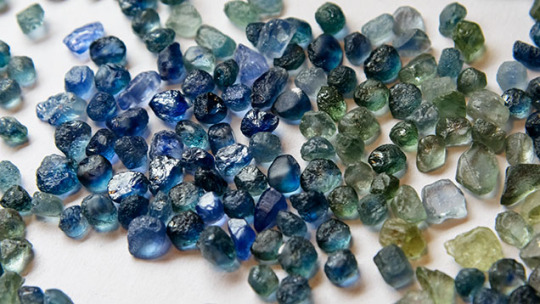
Final thoughts, writing about a mine can seem nerve-racking, intimidating, or just something that you want to briefly mention and move on from, but truly I think going into the weeds could really add something to a story! Even if stories are slightly inaccurate about information, I am still 100x more excited to see it mentioned in more detail than to see it as a sentence. Besides it is fantasy, it doesn't always have to be exactly like earth.
#geology#rocks#stem#science#creative writing#dnd#dnd worldbuilding#fictional world#worldbuilding#worldbuilding stuff#crystals#gemstone#writing resources#writing#fictional writing
72 notes
·
View notes
Note
Ohhh my gosh, thank you for your post about geologic events and tips on writing them! If you don't mind, can I ask you about cave systems? Some of the more commons types (mineral types and formations) vs some of the more spectacular/rare finds and the conditions for their formation?
Hello and thanks! Caves typically are formed out of limestone (a sedimentary rock). Limestone is a rock mostly made of calcite/ calcium carbonate that is formed in the ocean. Once the ocean level lowers or the land rises due to mountain building events, these rocks get exposed to the surface where rain (which is usually always a little bit acidic) will begin to react with the stone (Similar to your teeth and soda). Once this process begins it will make the caves we know and love.
There are a couple interesting things that can happen though! First, dissolving rocks means that the water is full of minerals, that means that while that water drips from the caves it will precipitate out those minerals creating stalactites and stalagmites on the ceilings and floors. This also means that they will be made out mostly pure calcite!
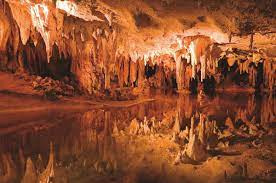
Another interesting thing is that because they were on the ocean floor, it means that there will be a lot of fossils present from an ancient ocean.
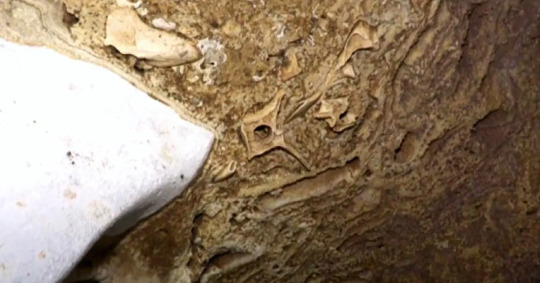
So, most times, the only things you will find in caves is calcite and fossils. However in some rare instances you can have salt caves, which are also sedimentary but would be associated with the drying of oceans (You would also be able to probably find gypsum in those caves as well).
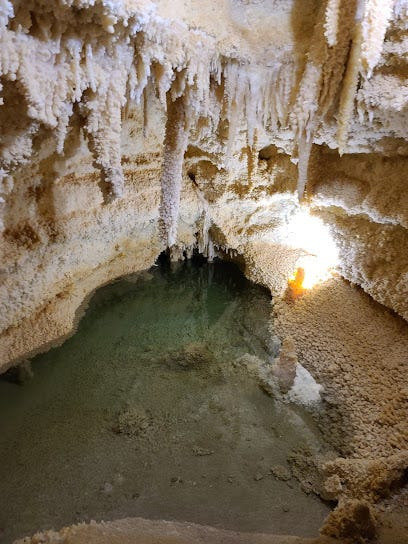
Other rare and interesting caves could be formed from hydrothermal water (hot water generated from volcanic activities), this opens up a world of different things that *could* be present including metals being deposited in the stone (gold, silver, or copper). That said, this is just me inventing excuses for if you want it to be mineable.
Some natural disasters associated with cave systems being under the land would definitely be sinkholes! There can also be entire rivers that just disappear underground.
I truly hope this helps! If someone who knows more about caves sees this, please feel free to add comments!
26 notes
·
View notes
Text
Geology of Natural Disasters and How to write them into your fictional universe.
So, you want to write about a natural disaster to advance your plot and torture your players/characters even more? Let me tell you how, accurately.
I feel like unless it is a volcano, natural disasters are a pretty slept on plot drivers, and some of them are really cool and unique! Today, I will talk to you about land slides, earthquakes (And earthquake related disasters), and volcanoes.
Landslides: Probably one I see the least in stories, but one that would be incredibly interesting to write into a plot where they believe in curses. Landslides can happen along ocean bluffs, slightly hilly areas, and highly mountainous areas, this means it is something that can happen in most landscapes. But what can trigger a landslide? Mostly all you need to trigger a landslide could be just abnormally large amounts of rain, excessive deforestation (with a little bit of rain), or an earthquake. If you don't want to use deforestation or an earthquake as a catalyst, a really cool indicator that the land is slipping and may be prone to a collapse is J hooked trees.
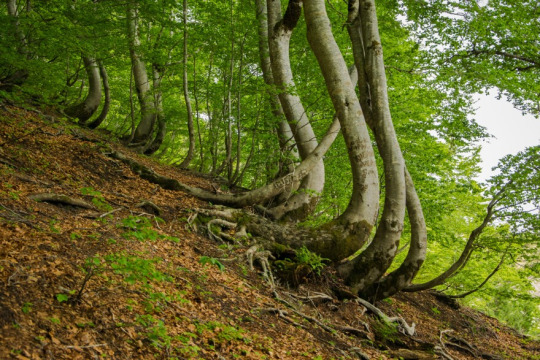
This indicates that there is soil creeping slowly over time, and it may lead to a major landslide.
2. Earthquakes: Probably one of the easiest things to write, earthquakes can happen anywhere, but they are most common in places that are tectonically active areas. There are about three types of environments you can expect earthquakes to be common. The first is just rugged mountains, if your landscape looks like this, you should write in earthquakes. Associated hazards could be landslides, avalanches, and large falling rocks.
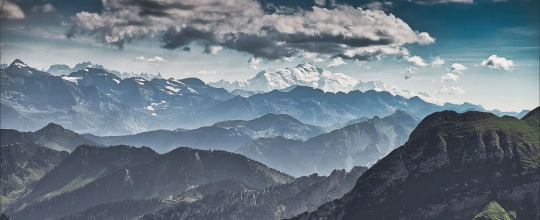
The next landscape could be a thin mountain range, next to the ocean, very scenic, but very dangerous. Essentially, I am describing a subduction zone environment.
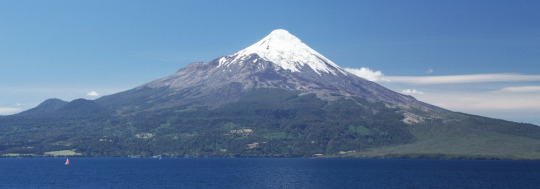
Earthquakes in these areas could equal a couple different associated disasters. Scenario one: A very large earthquake happens, and the ocean begins to recede. This is a tsunami, enough said. If you are writing a tsunami though, please, please, do not write it as a large wave, thank you. Also, a common way people are hurt by tsunami's are from them going into the ocean because they don't understand a tsunami is going to happen.
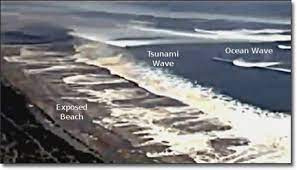
Scenario two: A large earthquake happens, your characters are in a valley and suddenly the ground begins to liquify as the ground shakes, once the shaking stops, the ground becomes solid like nothing ever happened, except everything has suddenly sunk into the now hard ground. This is called liquefaction and it typically happens in areas that have loose dirt or lots of saturated soil.
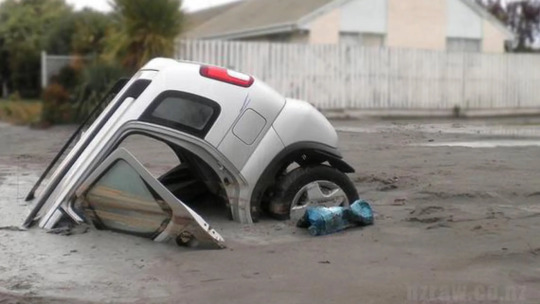
Scenario three: There are a lot of small earthquakes, they do not cause a lot of damage, but you begin to notice that one of the isolated mountains has a plume rising. Earthquakes can indicate lava moving underground and the filling of magma chambers.
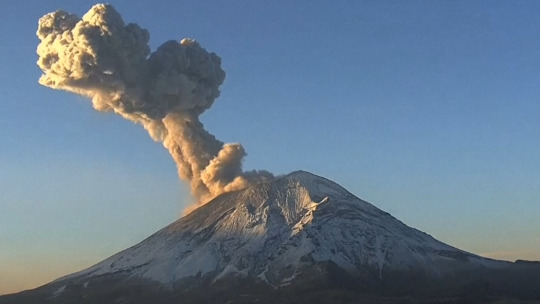
The next environment that can host lots of earthquakes would be regions that have a lot of really deep valleys and small mountain ranges (not cone volcanoes), but overall seems pretty flat.
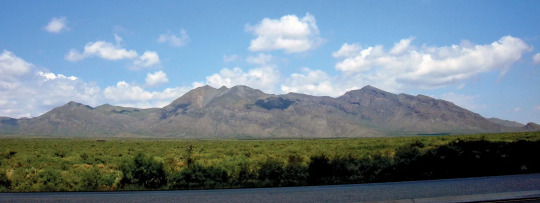
This indicates a transform fault like the San Andreas. If you want to hint at there being earthquakes in the area, you can show fence posts that are suddenly several feet out of line at a dilapidated farm or something similar.
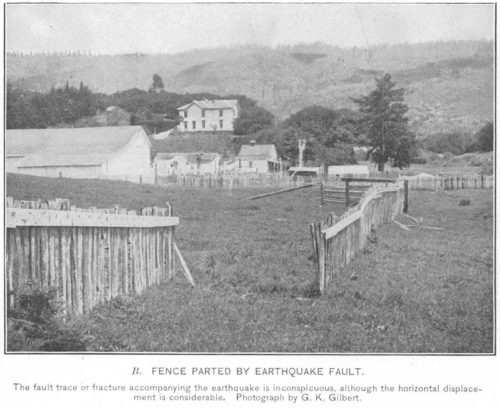
(These earthquakes are different because they are cased from sideways movement, not an up-and-down movement this hint can only be used for this environment). Volcanoes would not be found here, but liquefaction and landslides could still occur here.
4. Volcanoes: If you thought earthquakes had a lot of information, volcanoes do too. First you have to ask yourself, what kind of volcano you want to have, what kind of eruption style? So lets break down the kind of eruptions you can have and what their landscapes look like. Hawaiian Shield volcano: This will produce a smooth fast lava, the landscape typically is pretty flat, but there will be small cones and the rocks can have a ropey or jagged texture and the rocks will be almost exclusively black to dark red.
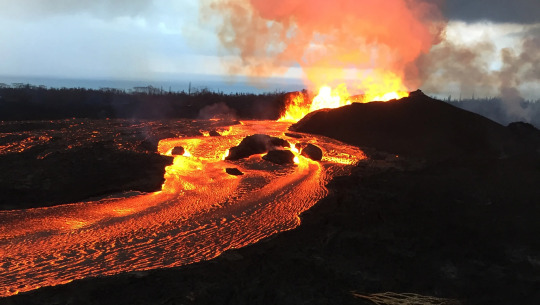
Stratovolcanoes: These will be solitary mountains, typically, that look like perfect cones (Picture shown in earthquake section). These will have large ash cloud eruptions and pyroclastic flows, they may have some lava, but typically most damage is done from the pyroclastic flows (think Pompeii). Some hints of these, other than describing the cone features (which can be hidden by other mountains), would be to talk about petrified wood! Trees can get fossilized in the ash and I imagine it would be very strange to find this rock that clearly looks to be a piece of wood, but its a rock. Subcategory- Calderas: Used to be a large stratovolcano, but they erupt so explosively that the entire cone collapses and creates a basin.
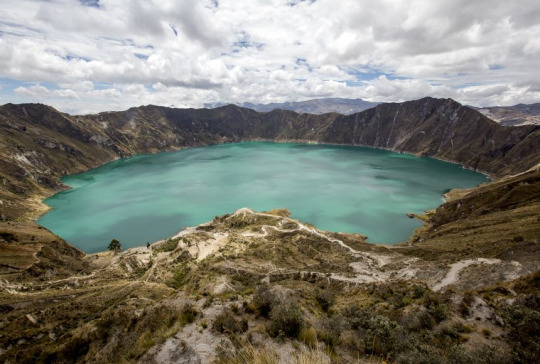
There are a lot of kinds of volcanoes out there, so forgive me for just putting an infographic and then talking to you about these really rare types of eruptions that I feel like people should know about.
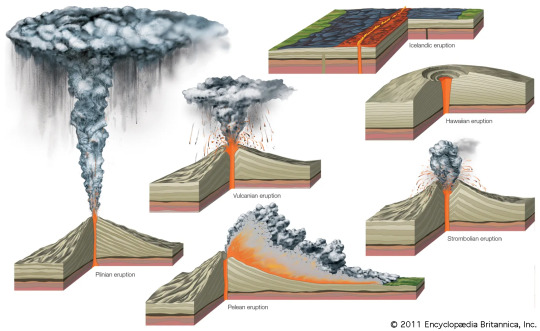
Okay lets talk about blue lava (kind of) and black lava

You will notice the lava is still red in the middle of this image, during the day these would look like a normal eruption, but at night the burning sulfur would make it appear blue. Some cool features other than this, would be that any water in the area would become very acidic and burn the skin due to sulfuric acid. This would again be really cool if you are trying to describe a 'cursed' land.
Black lava: This happens only in the east African rift I believe, but it is a carbonatite lava, but if you are writing in a rift valley (where the continent is tearing apart to form a new ocean) this might be a cool feature. The lava will cool white and will quickly erode, it makes for a very alien landscape!

Anyway as always, this is supposed to be an introductive guide for the basics of writing geology to create cool landscapes/features into dnd or fictional universes, if you are a geologist please understand my oversimplification of tectonics, I didn't want people to run away.
#geology#rocks#stem#dnd#dnd worldbuilding#worldbuilding stuff#fictional world#worldbuilding#fictional writing#writing resources#creative writing
5K notes
·
View notes